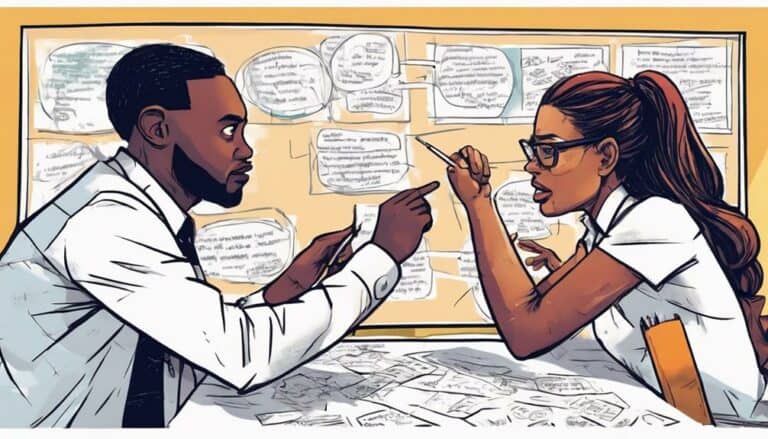Utilize collaborative problem-solving as a strategic approach to conflict resolution to enhance teamwork, communication, and innovation while fostering a positive work environment. Enhance communication skills, actively listen, address differing viewpoints constructively, and aim for compromise. Embrace open communication, practice empathic listening, and find common ground. Prioritize open communication, foster empathic listening, build trust, and encourage active listening. Overcome challenges by addressing personal differences, managing communication clashes, and working towards mutually beneficial solutions. Explore the outlined benefits, strategies, principles, techniques, and challenges to effectively implement collaborative problem-solving for conflict resolution.
Key Takeaways
- Utilize collaborative problem-solving techniques to address conflicts effectively.
- Enhance communication skills to ensure all perspectives are considered.
- Actively listen to all parties involved to promote understanding and empathy.
- Address differing viewpoints constructively to find common ground.
- Employ compromise, negotiation, and consensus-building for mutually beneficial resolutions.
Benefits of Collaborative Problem-Solving
Utilizing collaborative problem-solving not only enhances team cohesion but also fosters a positive work environment, setting the stage for improved problem-solving skills and innovative solutions. When conflicts arise among team members, the application of collaborative problem-solving techniques can notably improve communication and decision-making processes. By delving into the root causes of conflicts, teams engage in a resolution process that not only resolves the current issue but also prevents similar conflicts in the future.
This approach to conflict resolution not only addresses immediate concerns but also contributes to the overall work environment by promoting a culture of openness and transparency. Through collaborative problem-solving, teams can effectively navigate conflicts, leading to more efficient and productive outcomes. By focusing on problem-solving skills and encouraging innovative solutions, teams can enhance their performance and achieve long-term resolutions that benefit the organization as a whole. Embracing collaborative problem-solving as a core strategy can lead to sustained success and improved team dynamics.
Strategies for Effective Conflict Resolution
To effectively navigate conflicts and promote harmonious relationships within your team, employing strategic conflict resolution strategies is essential. Conflict management is an important aspect of maintaining a productive and positive work environment. By utilizing collaborative problem-solving techniques, such as finding common ground and working together to understand perspectives, you can effectively resolve conflicts and foster mutually beneficial solutions.
Effective conflict resolution involves enhancing communication skills, actively listening to all parties involved, and addressing differing viewpoints constructively. Through resolving conflicts in a collaborative manner, you can't only address immediate issues but also prevent future disagreements from escalating. Strategies like compromise, negotiation, and consensus-building play a crucial role in reaching resolutions that benefit all parties involved.
Key Principles of Collaborative Problem-Solving
Handling conflicts effectively within your team involves embracing the key principles of collaborative problem-solving, which emphasize open communication, empathic listening, and respectful exchange of opinions to address conflicts constructively. By ensuring that team members understand these principles, you can encourage open communication, find common ground, and resolve conflicts in a way that leads to mutually beneficial outcomes. To achieve this, it is essential to establish clear expectations, identify shared interests, and build trust among team members. The process of collaborative problem-solving focuses on creating an inclusive environment where desired outcomes are reached through cooperative efforts and inclusive communication. By leveraging these resolution skills, you pave the way for a more harmonious and productive team dynamic.
| Principles of Collaborative Problem-Solving | ||
|---|---|---|
| Open Communication | Empathic Listening | Respectful Exchange of Opinions |
| Finding Common Ground | Identifying Shared Interests | Setting Clear Expectations |
| Building Trust Among Team Members | Creating an Inclusive Environment | Leveraging Collaborative Communication Skills |
Implementing Collaborative Problem-Solving Techniques
To successfully implement collaborative problem-solving techniques, prioritize fostering open communication, empathic listening, and trust-building among team members. When conflicts arise, working together with a focus on understanding each team member's point of view is essential.
By encouraging team members to share ideas and actively listen to one another, the problem-solving process becomes more effective. Team dynamics play a significant role in how conflicts are approached and resolved. Understanding the pros and cons of different solutions can help in finding a resolution that benefits everyone involved.
By reducing conflict through collaboration, interpersonal conflicts can be minimized, leading to a more harmonious work environment. Building a culture that values collaboration and open communication is key to successfully implementing collaborative problem-solving techniques.
Overcoming Challenges in Conflict Resolution
When faced with challenges in conflict resolution, addressing personal differences, communication clashes, and disagreements over problem-solving processes is essential for successful collaborative problem-solving. Managing conflict by finding common ground is pivotal.
Working together to find possible solutions requires maneuvering conflicts with empathy and active listening. It's critical to keep track of different perspectives and be open to compromise. Utilizing a third-party mediator can sometimes facilitate the resolution process by providing an unbiased perspective.
By actively listening to all parties involved and understanding their viewpoints, you can work towards finding mutually beneficial solutions. Remember that effective conflict resolution through collaboration not only resolves immediate issues but also strengthens relationships and fosters a more positive work environment.
Implementing techniques like compromise, negotiation, and empathetic communication can help overcome challenges and lead to improved organizational efficiency and operational effectiveness. Embrace the opportunity to turn conflicts into opportunities for growth and enhanced teamwork.
Conclusion
Well, congratulations! You now have all the tools you need to successfully navigate conflicts using collaborative problem-solving techniques. Who knew that working together could actually make things easier?
Keep in mind that conflict resolution is just another opportunity for growth and learning. So go forth, armed with your newfound skills, and conquer those conflicts with a smile on your face.
Who knew conflict resolution could be so fun?

